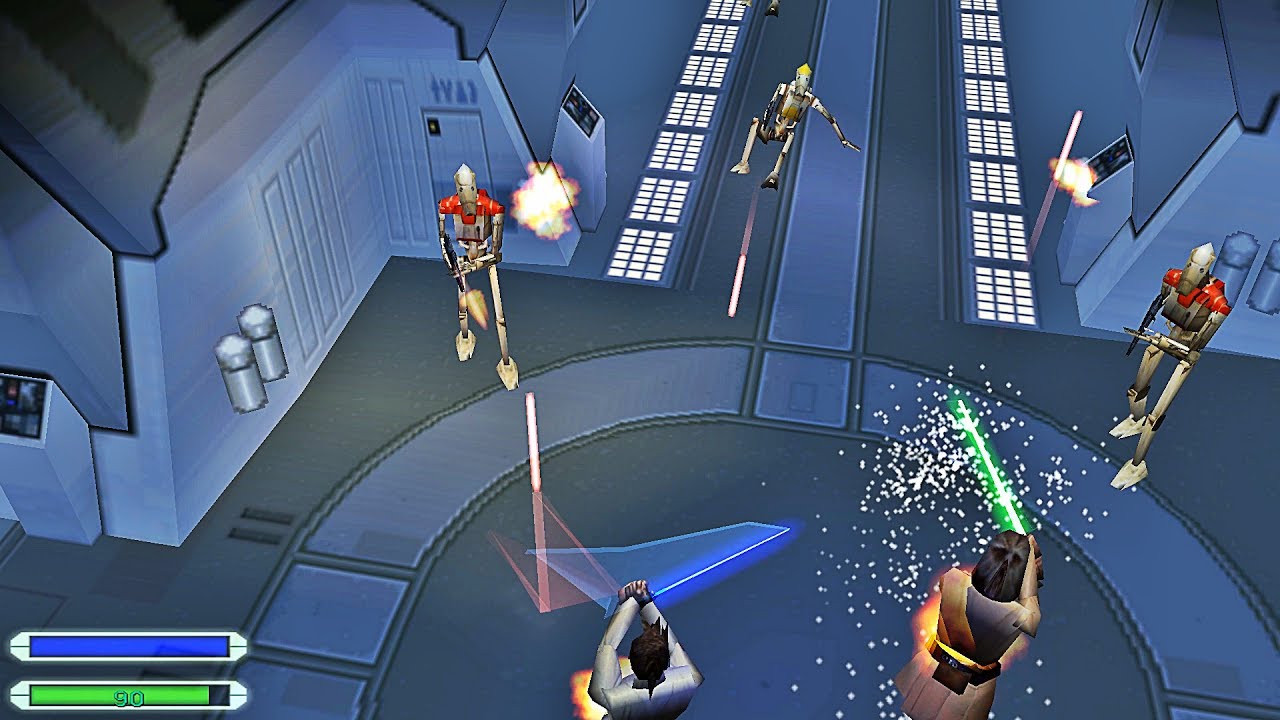
Movie licenses have always been sort of a gamble on the part of a game company. Many fail to spark the imagination in the same way their motion picture counterpart did. (Example: Any of the Jurassic Park games.) Some, however, turn out to be quite entertaining, even spawning an entire franchise. The Star Wars license has produced more games than any other movie license to date. With games spanning a list of systems that reads like a timeline of video game history. The arcade, Atari 2600, Nintendo Entertainment System, Sega Master System, Super Nintendo, Sega 32X, the PC, Nintendo 64 and the PlayStation have all had Star Wars-based games available. While not all of them have been great, most have been regarded as pretty good. It’s too bad The Phantom Menace, based on the most recent entry in the Star Wars canon, isn’t one of the great ones. In fact, it’s barely any good.
Originally scheduled for a dual release on the PC and the PlayStation, this third-person action/adventure game allows you to navigate through the biggest movie of the year’s main scenarios, as well as a few that weren’t included in the film. You move your character (either Obi-Wan, Qui-Gon, Queen Amidala or Captain Panaka) around, performing a variety of actions that mainly include blowing things up and jumping around. Dialogue, which normally plays a large role in an adventure game that bothers to include it, takes a backseat to finding switches and the proper way to access a part of each level. You can talk to other characters, just don’t expect much in the way of insight from their responses.
The graphics are fairly decent. The characters are all fairly well represented in polygonal form. Some fare a bit better than others, but they are all recognizable. The weapons produce some rather interesting, if not spectacular, lighting effects. The thermal detonators, when they go off, provide a nice shock-wave effect that is as deadly as it is cool to look at. My combination of a Voodoo II 12 MB card and 32 MB of RAM was considered a “medium” level system and the game automatically set up a default set of graphics effects, like particle animation and shadows, that were turned on. I switched my machine into the next lowest setting and the game still looked respectable. The higher, “balls-to-the-wall” setting bogged my machine down and caused the action to get choppy, but it did look very nice!
Problems arise however when you’re actually playing the game. The camera view is placed slightly behind and way above the character you control. This prevents you from seeing what lies more than approximately 20 feet in front of you. I found myself searching for a way to adjust it to a more Tomb Raider-style perspective, but, alas, no such luck. This hampering view allows off-screen enemies to shoot you before you can even see where they are, which is absolutely not cool. Even though the blaster shots move pretty slowly, the sheer number of enemies firing at you can become overwhelming at times.
The game allows your character to jump and roll, as well as walk and run. However, all of these actions feel as if Obi-Wan or Qui-Gon have lead weights tied to their ankles. Turning to walk in a particular direction just feels clumsy and sluggish. The Phantom Menace just doesn’t control as smoothly as a game of this nature should.
Even though the game provides a cool soundtrack, courtesy of John Williams’ movie score, and nostalgic sound effects, such as the lightsaber’s signature “whoosh” and the countless blaster noises, it’s hard for me to avoid talking about the voice acting. Although Jake Lloyd (Anakin Skywalker) and Ahmed Best (Jar Jar Binks) provided the voices for their characters, the main voices of Obi-Wan Kenobi and Qui-Gon Jinn, in particular, sound like horrible impersonations. Well, at least whoever played Obi-Wan tried to sound like Ewan McGregor. No such effort was put forth by whoever played Liam Neeson’s part.
An action game featuring the Star Wars universe is not exactly a no-brainer. Many integral things need to be in place for the game to successfully bridge the gap from movie screen to computer monitor. One example is having the characters act as they do in the movie. For example, I wouldn’t expect R2-D2 to jump into the cockpit of a starfighter and start blasting enemy ships out of the sky. So, why then does this game ask a Jedi Knight to pick up a blaster and start blazing away at enemies? I found this extremely out-of-character and, while deflecting blaster shots with the light saber does get kind of old after a while, I still don’t think the characters should deviate THAT much from what’s been seen in the movies. Even the signature “Force” power is watered down. In the movie, it was a little more effective at handling enemies than it is in the game. Am I nitpicking? Possibly, but it still irked me that they’d ask Star Wars fans to forget that Jedi Knights consider blasters as inferior to the lightsaber and use of the Force.
As much as I wanted to like this game, I cannot recommend it. Although taken individually, my complaints may not seem like much. Add them up and you have a less-than-satisfying gaming experience that’s definitely not worth the price of admission. Save your money and see the movie a few more times instead.
4 out of 10.
System Requirements: Pentium 200 or higher; 32MB RAM or higher; 4X or faster CD-ROM drive; Direct3D compatible hardware accelerator required. Joystick and gamepad supported.
Tested on: Pentium II 233 MHz, 32 MB RAM, 32X CD-ROM drive, Best Data Voodoo 2 12 MB accelerator, Saitek X6-32M gamepad.

